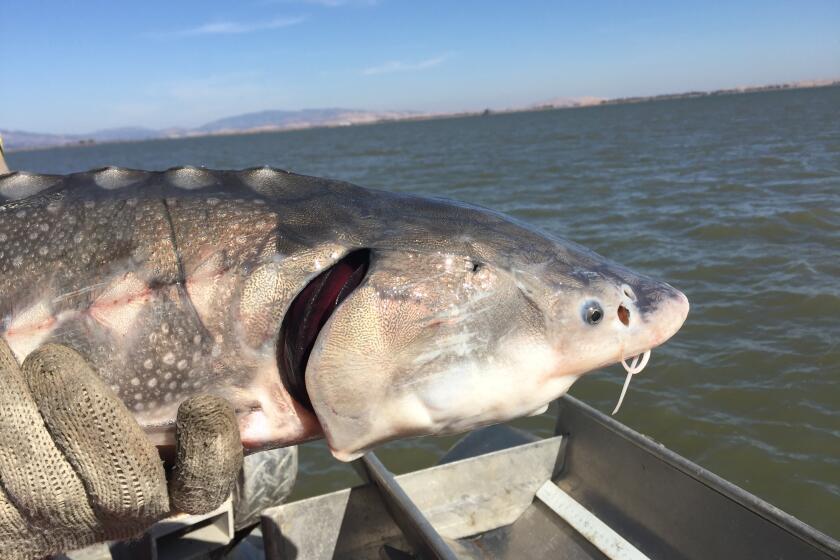Group Acts as Protector of Animal Stars in Movies
A blindfolded horse’s plunge to its death down a 70-foot cliff in southwestern Missouri during the making of the movie “Jesse James” nearly 50 years ago is still causing reverberations in the entertainment community today.
The 1939 movie by 20th Century Fox featured a thundering chase in which Tyrone Power as the outlaw James was pursued by a posse on horseback to the edge of a cliff. There, James and his horse made a daring leap to freedom.
To shoot the scene, a stunt man raced the blindfolded horse onto a sloping greased platform rigged to tilt and plunge horse and rider to the water below. The stunt man, knowing what to expect, survived. The horse fell to its death.
Stung by public fury when the incident came to light, image-conscious producers asked the Denver-based American Humane Assn. to come to Hollywood to police the treatment of animals in the entertainment industry, said Carmelita Pope, the former actress who has been the association’s director since 1979.
Watchdog Agency
In the years since the horse’s death, the association has served as the quasi-official watchdog of animal actors, from Francis the Talking Mule to Rin Tin Tin and Flipper. Today, the association is widely credited with drastically decreasing the incidence of animal cruelty in films.
Admirers and foes say the association has achieved tremendous power and credibility in the film community.
Working out of a small suite on Ventura Boulevard in Sherman Oaks, the association champions the rights of horses, domestic and wild cats, dogs, chimpanzees, pigs, sheep, rats--even fish, birds, spiders and snakes--used in movies, television shows and commercials.
“We feel that the motion picture and television industry touches so many lives that the people watching these productions should be assured that the animals were not abused in any way for their entertainment,” Pope said.
Breaks for Tired Animals
The association’s protection may involve rescuing a tired dog from an exacting director by ordering a break after 30 takes of a dog-food commercial, making sure goldfish are put back into water quickly after their fish bowl is filmed smashing to the floor or checking the ground on which a horse is to run to make sure there are no gopher holes or overhanging branches.
Pope said the association also takes measures that protect actors and crew, such as making sure a rattlesnake is milked before a scene or asking a cameraman filming a puma to sit behind a shield.
During filming of “Down and Out in Beverly Hills,” an association investigator stood by to make sure Mike the Dog was not exhausted by his rigorous shooting schedule.
An investigator recently went to the set of the movie “Hanoi Hilton” to protect rats, lizards, spiders and other insects used in the picture, Pope said. Pope acknowledged the impossibility of detecting exhaustion in a bug. The investigator was simply making sure they weren’t squished, she said.
One investigator recently traveled to Santa Fe, N.M., to spend 10 days protecting a pig--several pigs, really, including stunt doubles--prominently featured in the Robert Redford film “The Milagro Beanfield War.” The pigs were treated fine, the investigators said. The worst thing that happened to them, a publicist for the film said, was that they got fatter from constant food rewards received for performing.
Clint Eastwood’s longtime producer, Fritz Manes, who has worked with apes, ferrets, snakes, rats and other creatures under the association’s scrutiny, called the organization “terrific.”
“I think they do a marvelous job of watching the movie industry and keeping people aware of how animals should be treated,” he said.
Mark Locher, a spokesman for the Screen Actors Guild, agreed, saying there are virtually no reports of animal abuse in American films these days, in large part because of the association.
Wrangler Disagrees
But a contradicting view came from Rudy Ugland of Saugus, a wrangler who trains and supplies horses to film makers and coordinates location work involving horses. Ugland has drawn the association’s fire on several occasions for animal stunts in films such as “Heaven’s Gate” and “The Missouri Breaks.”
Ugland denied having inflicted cruelty on animals and criticized the association, saying its investigators “couldn’t tell you which end you put a bridle on one of these horses. I think it’s hurt the whole business.”
Pope dismissed such criticism, as well as frequent complaints from stunt men that animals are better protected than stunt men are.
“Stunt men have voices. All they need to do is use their own good common sense and say, ‘I won’t do that, that’s dangerous.’ And they enjoy those nice fat paychecks,” she said. “The animals just get fed.”
Pope, who is probably best known for her roles in soap operas and as a spokeswoman for Pam vegetable spray, heads a staff of six, including four uniformed field investigators who are sent to monitor the filming of scenes with animals.
Licensed by the state as humane officers, the investigators have the authority to “walk in front of the camera and stop filming,” Pope said. Anyone who defies the investigators can be arrested, including a director, although no investigator has ever made an arrest, she said.
The association’s annual $200,000 budget is paid largely by the association’s Denver headquarters, supplemented with public donations.
The association does not object to the depiction of cruelty to animals but only to actual cruelty. “If a boy kicks a dog in a movie, it’s setting a bad example, but, if there’s no contact between the foot and the dog, we can’t object. That would be censorship,” Pope said.
In fact, the association condoned one of the most jarring scenes of seeming animal brutality in film history: a scene in the movie “The Godfather” in which the head of a recently slaughtered horse was placed in the bed of its movie chieftain owner.
To film the scene, the movie makers went to a slaughterhouse, picked out a horse that looked most like a thoroughbred and requested that it be kept alive until needed for filming. At the proper time, the animal was sent to slaughter; its head was cut off and used for the scene, Pope said.
Pope said the decision to approve the scene was made before she came to the association. Although the action conceivably extended the horse’s life, she said, she would not have granted permission. “I don’t think animals should be killed for movies for any reason,” she said.
Tripping Horses
Actor David Carradine praised the association, despite the unacceptable rating it gave to his movie “The Long Riders,” because horses in the film were allegedly tripped with wires. Carradine said he believes the association overreacted--the horses were trained to trip safely.
Still, Carradine now requires a provision in all of his movie contracts stating that animals must be treated according to the association’s standards or he will walk off the picture.
Carradine said in a telephone interview that he began insisting on the provision because Swedish director Ingmar Bergman killed a horse during filming of “The Serpent’s Egg” in Germany in 1976.
Carradine, who starred in the film, said he got to the set one day and found the horse, which had been shot. Its body was still steaming, Carradine said. Butchers, hired to play the roles of starving citizens, began cutting up the horse, Carradine said.
Carradine said he was so upset that he “developed a nervous tic in my left eye that took me six to eight months to get rid of.”
Treatment for Star Animals
Cruelty to animals is as old as the movies, association office manager Bill Wood said. Star animals such as Asta and Lassie have always been well cared for, but other less valuable animals fared far worse.
Perhaps the worst off were horses in early Westerns, Pope said. Although horses can be trained to fall, it was cheaper and quicker to trip them, using pits dug in the ground or wires tied to legs. Eyes were gouged out, jaws, legs--even necks--were broken, and horses died and suffered, Wood said.
“In those days you could replace a horse for $10. Why train one?” Wood said. The tripping methods are still used today, although less frequently--and not without invoking the association’s wrath.
When it came to Hollywood in 1939, the association drew its power from the Motion Picture Assn., which pronounced the humane association the official industry watchdog. A resolution banning cruelty to animals was added to the Motion Picture Production Code, Pope said.
But producers began defying it in the late 1950s and early ‘60s. Association investigators were allowed to monitor filming only at the whim of producers and directors.
Pope said that was when cruelty began creeping back into films.
The turning point was the 1981 Michael Cimino movie “Heaven’s Gate.”
The association alleged that, during filming of the movie in 1979 in Montana, a horse was killed in a dynamite explosion that also injured the rider. It also alleged that four other horses died of neglect or accidents and that there were other instances of cruelty, including cock fighting and the bleeding of horses and cattle for blood to smear on the actors.
Cimino could not be reached for comment. The film’s producer, Joanne Carelli, reached by telephone in New York, refused to respond to the allegations. “We’ve had it with these people,” she said.
Ugland, the head wrangler on Heaven’s Gate, said the association’s allegations were false.
“A horse was injured in an explosion but not killed,” Ugland said. “There were no animals killed on the show, not by purpose and not by accident.”
Encouraged by the association, a Lake View Terrace woman whose purebred Arabian show gelding was used in the movie filed a lawsuit in October, 1980, in Los Angeles Superior Court seeking more than $1 million in damages from Cimino, Carelli, Ugland and the production company. The woman alleged that her horse was physically and psychologically abused by the film makers.
Pope, who had hoped to make an example out of Cimino, was bitterly disappointed when the horse’s owner settled out of court.
However, because of the allegations, the association was given more power. The 1980 SAG-Producers Basic Codified Agreement requires producers to provide scripts and notify the association before beginning work involving animals. Association investigators may also be at the filming of such scenes, the agreement says.
Many producers, accustomed to the arrangement, routinely supply scripts. More often, Pope said, “we have to dig it out ourselves.”
Scripts Scanned
To keep abreast of new productions, Pope and two office workers comb through Daily Variety and the Hollywood Reporter, then contact producers asking for scripts. Each afternoon, stacks of scripts that have been mailed or delivered to the office are scanned for scenes that are potentially dangerous or stressful to animals.
If investigators cannot be sent to the sets of such productions, the association attempts to monitor scenes involving animals by telephone.
On one recent day, a pile of scripts lay on Pope’s desk. Scenes involving animals were marked by turned-down pages and a yellow felt-tip marker.
Pope’s eye caught a sequence in a Cannon Films script, “Doin’ Time on Planet Earth.” The script called for a “man-eater plant” to swallow a toy poodle. The dog was to be heard yelping hysterically from inside the plant. Then, the plant was to cough up a mass of oozing slime--including the dog--which was by then to be hairless.
“Hmmmm. You’d better send Roy on this,” Pope said, referring to the association’s most experienced investigator. “Find out about this scene.”
As it turned out, the scene was cut from the production for reasons unrelated to the humane association. Toy replicas were used for other parts of the script.
But Pope sent investigators to the Madonna movie, “Slammer,” to monitor the use of cougars and to the Arnold Schwarzenegger film “The Running Man” to protect six Dobermans.
On another recent day, investigator Sharon Nogg went, as she frequently does, to the set of the one-hour dramatic NBC-TV series “Our House” to ensure the welfare of its basset hound star, Arthur. Arthur’s not-too-complex role that day: looking at members of his fictional family as they spoke. The dog, handled by his trainer and viewed affectionately by cast members, was well treated.
Sometimes, the association simply gives advice on how to handle or film a scene with an animal. For instance, a recent Walt Disney script, “The Deacon Street Deer,” called for a child to pick up a limp fawn, which was to be sedated for the shot. Informed that the stunt was dangerous to the fawn, Disney substituted a stuffed toy deer, Pope said.
Accidental Cruelty
Not all cruelty is deliberate. During filming of the TV miniseries “The Thornbirds,” an actor who was being taught to shear wool accidentally gouged a sheep’s esophagus, killing it, and another actor sheared off a sheep’s nipple, the association alleged.
Because it was a rehearsal, the association was not present. But alerted by calls from upset and angry actors, two association investigators went to the set and told director Daryl Duke that he would be arrested if actors again touched shears to sheep. He was cooperative, Pope said.
Duke confirmed that actors were taught to shear sheep for the movie but said he couldn’t recall “the extent of injury.”
There are laws prohibiting cruelty in California and other states and also a federal animal welfare law, Pope said, but “the problem is you have to have eyewitnesses to prosecute, and in this billion-dollar business you’re never going to get anyone to testify.”
Once filming is completed, the association has no official power, but does have remedies. The association screens films in advance and, based on the way animals are treated, rates them as acceptable, believed acceptable, questionable or unacceptable.
The ratings are sent to animal-rights organizations, journalists and movie censors across the country and the world. About 80 films have been deemed unacceptable.
Since 1981, only one film made in the United States has been rated unacceptable, and it was a non-union production and therefore exempt from the SAG contract, Pope said. The film was director Roger Corman’s “Suburbia.”
The association has no jurisdiction over films made out of the country, an increasing trend in recent years.
But the association can bring to bear the ire of a well-organized cadre of animal lovers who picket, write letters and boycott movies.
For instance, the association gave an unacceptable rating to the 1982 Arnold Schwarzenegger film “Conan the Barbarian”--filmed outside the country--because horses allegedly were tripped, Pope said. Outside the Hollywood theater where the film opened, actress Loretta Swit and about 50 other association supporters carried signs and passed out literature condemning the movie, Pope said. “A lot of people turned around and got right out of line,” Pope said.
Later, the association gave “Conan” director Dino DeLaurentiis more than 6,000 letters from animal lovers across the country protesting the movie. The association was welcomed to monitor DeLaurentiis’ next picture, Pope said.
The association frequently tries to persuade networks and television stations not to show movies rated unacceptable or at least to cut scenes involving animal cruelty.
More to Read
The biggest entertainment stories
Get our big stories about Hollywood, film, television, music, arts, culture and more right in your inbox as soon as they publish.
You may occasionally receive promotional content from the Los Angeles Times.






